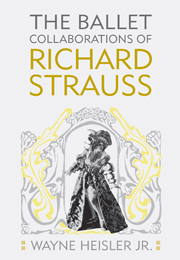Book contents
- Frontmatter
- Contents
- List of Illustrations
- Acknowledgments
- Introduction: Richard Strauss, Dance, and Ballet
- Part One Becoming a Ballet Composer, 1895–1914
- Part Two “To drive away all cloudy thoughts,” 1919–1941
- 3 The Strauss–Heinrich Kröller Ballettsoirée (1923) and Interwar Viennese Cultural Politics
- 4 Kitsch and Schlagobers (Whipped Cream, 1924)
- 5 Verstrausster Couperin, Verklingender Strauss, Verklungene Feste: Tanzvisionen aus Zwei Jahrhunderten (Bygone Celebrations: Dance Visions from Two Centuries, 1941)
- Epilogue
- Notes
- Works Cited and Consulted
- Index
- Eastman Studies in Music
3 - The Strauss–Heinrich Kröller Ballettsoirée (1923) and Interwar Viennese Cultural Politics
from Part Two - “To drive away all cloudy thoughts,” 1919–1941
Published online by Cambridge University Press: 12 September 2012
- Frontmatter
- Contents
- List of Illustrations
- Acknowledgments
- Introduction: Richard Strauss, Dance, and Ballet
- Part One Becoming a Ballet Composer, 1895–1914
- Part Two “To drive away all cloudy thoughts,” 1919–1941
- 3 The Strauss–Heinrich Kröller Ballettsoirée (1923) and Interwar Viennese Cultural Politics
- 4 Kitsch and Schlagobers (Whipped Cream, 1924)
- 5 Verstrausster Couperin, Verklingender Strauss, Verklungene Feste: Tanzvisionen aus Zwei Jahrhunderten (Bygone Celebrations: Dance Visions from Two Centuries, 1941)
- Epilogue
- Notes
- Works Cited and Consulted
- Index
- Eastman Studies in Music
Summary
Anyone who sets out to write about Richard Strauss during the interwar period has some explaining to do. The 1920s have come to represent the composer's personal and professional nadir—at least up to that point—one plagued with emotional despondency in the wake of World War I, financial insecurity, and, in the words of Michael Kennedy, a “growing awareness that he and his music were becoming almost grotesquely out of tune with the times.” Crudely glossing on Adorno, whose first critical essay devoted solely to Strauss was published in 1924, one wonders if the composer himself had become aware of the dire state of the “truth content” of his music. Practical duties surrounding his codirectorship of the Vienna Staatsoper (1919–24), but also disorientation in light of what has been termed a “revaluation of all values” in interwar Europe—monetary, moral, political, social, cultural, and aesthetic—caused Strauss to relegate composition temporarily to the back burner. Or at least it would seem so given the paucity of major, canonical works that issued from the composer's pen in the 1920s. Although Strauss's 1924 domestic opera Intermezzo has been singled out for what a twenty-first-century observer might deem its modernist “street cred” (it was one of the few Strauss works that Schoenberg held in high esteem), and although Arabella (1929–32, premiered 1933), the last collaboration with Hugo von Hofmannsthal, has achieved semicanonical status, Strauss's mixed bag of instrumental, dramatic, and vocal pieces from the 1920s has seemed to be of negligible worth—irrefutable evidence of a backward turn, both aesthetically and technically, that had begun with Rosenkavalier.
- Type
- Chapter
- Information
- The Ballet Collaborations of Richard Strauss , pp. 99 - 126Publisher: Boydell & BrewerPrint publication year: 2009

